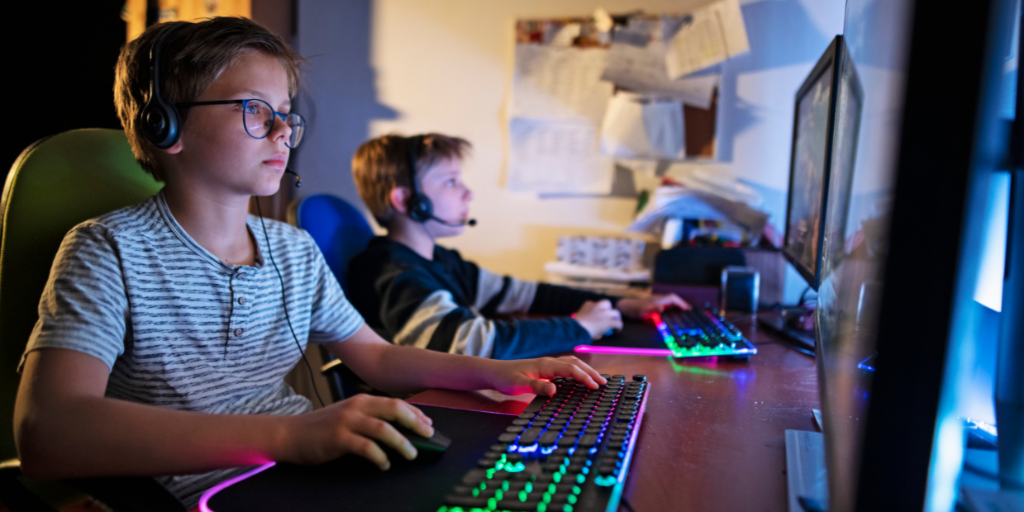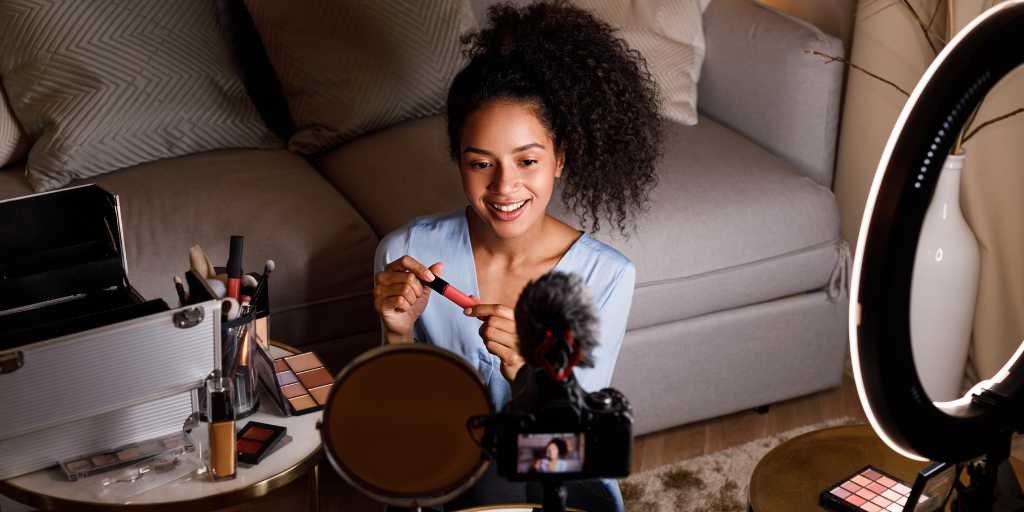
Most experts agree that parents should take an active role in supervising their child’s digital life. But what does that actually look like? And how should it shift as kids get older?
To help you craft a plan for supervising your child online, we’ve created guidelines based on three general age groups. Of course, children mature at different rates, and every family is unique.
The best plan uses these guidelines as a jumping-off point and creates an approach that works for you and your family. Consider writing your plan into a digital device contract.
The way you supervise your child’s online activity should change as they age, become more independent, and show that they’re able to follow your rules. The level of supervision a 6-year-old needs online is a lot different than that of a teenager.
These kids are just starting to use devices. They’re able to handle using a tablet or smartwatch, but still need plenty of guardrails. We recommend the highest level of parental involvement for this age group.
Limited access to apps and websites: Choose websites and apps geared toward younger kids, such as Kinzoo or PBS Kids. Common Sense Media is a great resource to help you vet movies, TV shows, and other media your child might want to watch.
Parental controls: Use the parental controls available on devices and in apps. For example, Apple Family Sharing enables parents to set rules around their child’s device use, from what they can download to how much time they spend on screens.
Tech check-ins: Talk to your child about the content they’re consuming, and periodically watch it with them. This is a great opportunity to start teaching them about things like respecting limits and how to spot advertisements.
Parental monitoring services: A service such as BrightCanary uses AI to monitor your child’s digital activity and alerts you to any red flags, all from your phone. That way, you don’t have to manually review everything your child watches.
These kids have shown they can reliably follow household rules around screen time and are ready for more digital freedom. They can handle access to a wider range of apps and content, but still need regular supervision.
More access to apps and websites: It’s not advisable to give your child free reign online yet, but you can involve them more in decisions. They’re likely to hear about different apps and games from friends, and they may want to start exploring topics of interest online a bit. Establishing an expectation of open communication and using the other suggestions on this list will give them measured independence in a structured, safe way.
Parental controls: Parental controls are still a good idea, but you can consider loosening up a bit. For example, you might allow your child to use chat features inside games, but limit those conversations to friends they know in real life
Tech check-ins: This age also benefits from regular check-ins, including periodically looking at content with them. Conversations can progress to topics like staying safe from online predators.
Parental monitoring services. A monitoring service is also a benefit at this age. Make sure you’re being transparent with your kids about why and how you’ll use it.
If your child handled the freedoms of the middle years well and wants to forge their independence, it’s appropriate to allow more digital freedom.
At this age, many kids start using social media and get a smartphone for the first time. Staying involved as they learn the ropes, while allowing them more autonomy, establishes the foundation for a lifetime of good digital habits.
Independence (with guidelines): Micromanaging your tween or young teen online is not only likely to be met with resistance—it’s apt to backfire and cause them to go behind your back. Instead of strict limits and requiring them to okay every digital choice with you, explain the online behavior you expect, let them know what types of content are off-limits (and why), and be clear they can come to you for guidance.
Tech check-ins: Check-ins shouldn’t stop at this age, but it’s appropriate to shift to more of a partnership. Rather than imposing a list of rules, talk to your child about how to make their own decisions using a values lens and enlist their suggestions for reasonable guidelines. Continued conversations on safety are increasingly important as your child gains independence, including talking to them about cyberbullying.
Monitoring services. Using a monitoring service as you give your child more independence might seem counterintuitive, but it’s actually the perfect compliment to this phase. Because a service like BrightCanary scans your child’s online activity, you won’t need to be as involved day-to-day. Periodically looking at their social media feeds together is still a good idea, but knowing that you’ll be alerted to problems allows you to take a step back and give them more autonomy.
Parents should take an active role to monitor their child’s online activity, but that involvement should shift as children age and mature. Supervising your child’s internet use isn’t just a matter of installing a parental monitoring app — it’s a multi-layered approach that involves regular check-ins, looking at material together, and having plenty of conversations together.

For tweens and teens, group chats have become the modern equivalent of cliques, extending from iMessage and WhatsApp to social media messaging. If you’ve ever watched your offspring huddled over their device, typing furiously, or heard the rapid-fire ding of alerts, you know what I’m talking about. But are group chats safe for kids?
Just like cliques that cluster next to lockers and gossip that spreads through whispers, group chats come with their own set of issues. Because of the important role group chats play in kids’ social spheres, it’s crucial for parents to understand this digital landscape so they can support and guide their kids through the ups and downs.
Kids are gonna be kids, and for many, that includes a decent dollop of drama. But group-text drama has its own particular flavor.
Without things like vocal inflection, facial expressions, and body language, it’s easy for misunderstandings to occur. And because multiple people are involved, a minor dustup can quickly snowball.
Here’s what to keep an eye out for:
From not inviting someone to a chat in the first place, to removing them, to using the thread to make secret plans, group chats are a prime place for exclusion.
Excessive complaining about people not on the thread, passive-aggressive barbs lobed at each other, and even downright aggression are a few of the ways toxic chats can adversely impact the mood and wellbeing of the participants.
Cyberbullying is a significant issue facing today’s kids, and this behavior often shows up in group chats. Whether your child is being bullied or participating in the bullying, parents need to watch out for this behavior in group chats.
Even if your kiddo is a passive observer to the toxicity, drama, or cyberbullying in their group chat, because their name is on the thread, they may be associated with it anyway.
Fear of missing out (FOMO) can make it hard for kids to put down the phone and get the shut-eye they need. They may feel afraid that something big will happen in the group thread while they’re asleep, so they stay up into the night.
Even if your child puts the phone down at a reasonable hour, they might wake up to dozens — or even hundreds — of messages. This bombardment first thing in the morning can be overwhelming as they try to catch up.
Your child may be added to a group chat with people they don’t know. At worst, this situation can expose them to predators, especially if the stranger begins talking to them one-on-one. Tell your child they shouldn’t engage in group chats with people they don’t know.
At BrightCanary, we’re big proponents of staying involved in your child’s digital life. That includes setting boundaries around device usage and regularly monitoring their text threads and social media inboxes.
It’s also important to keep the lines of communication open. Ask your kid who they’re messaging, and let them know they can come to you when problems arise. You can also use a text monitoring service like BrightCanary to keep tabs on their messages and step in when they encounter anything concerning.
So, are group chats safe for kids? Although group chats can be treacherous, they do have an upside. For many kids, they provide a sense of community and acceptance, are useful for forging and maintaining friendships, and can strengthen social connections.
But the downside of group chat dynamics is serious, too. That’s why it’s important to talk to your kid about the pitfalls and help them develop skills for participating in positive ways.
Here are some tips to get the conversation started:
A quick note on that last point — skipping out on a chat with no explanation can cause social problems, so your child may need some coaching on exiting gracefully. Their approach will depend on the situation, their personality, and the group dynamics.
Here are some ideas around what they can say:
Group chats are a major component of kids’ social lives today, but they can often be fraught spaces. Parents need to learn the dynamics of group chats so they can guide their children toward a positive messaging experience.

Cyberbullying has been around as long as the internet. But social media, in particular, comes with unique avenues for bullies to exploit. It’s important for parents to understand how cyberbullying occurs on social media and learn how to help if their child becomes a victim.
Unfortunately, there are plenty of ways for kids to get harassed on social media. That’s one of the reasons it’s important to regularly check in with your child about their social media use, whether you use a monitoring app or spot-check their phone (or both). Here are some of the most common ways your child might experience cyberbullying on social media.
Forget traditional text messages — most tweens and teens communicate with their peers primarily through direct messages (DMs) on social media. That may include sending harassing or threatening DMs intended to bully the recipient.
In fact, 59% of teens experience online abuse, and 25% say they’ve received explicit images they didn’t ask for.
If you’ve spent any time on social media, you know how easily a comment thread can turn into a raging dumpster fire. Cyberbullies often make nasty comments on their target’s social media posts, which can quickly snowball as others join in.
Doxxing involves publishing a person’s private information online without their consent. It originated with ‘90s hacker culture, but has since taken its place on the mainstream internet, particularly with the rise of social media. The information revealed in doxxing can vary from embarrassing to dangerous, and it’s often accompanied by threats or inciting others to harass the targeted person.
We all laugh at a good meme now and again — but they can be a tool for cyberbullies, too. Sometimes, bullies take photos or videos of their targets and turn them into cruel or embarrassing memes, spreading them across social media. Due to the viral nature of memes, the damage inflicted on your child can be long-lasting.
Part of the internet’s appeal for bullies is the ability to remain anonymous. A bully may create a fake account or screen name — sometimes referred to as a sockpuppet — in order to fly under the radar.
A teen may use a fake account to strike up an online relationship with a peer, then spread the personal information gained in their conversations.
One of the many reasons to warn your child about the risks of sexting (including through DMs) is the possibility that the photos or videos can be shared online without their consent. This can happen if the relationship goes sour or the material finds its way into someone else’s hands.
Snapchat (or “Snap,” as your kids likely call it) is a photo- and video-based instant messaging app that is especially popular with teens and tweens. Messages on this platform can disappear either immediately after being viewed or within 24 hours, based on the sender’s selected settings.
The impermanent nature of Snaps make them particularly well-suited for cyberbullying. Victims may question what they’ve just seen or fear not being believed because they have nothing to prove it happened — making victims of cyberbullying hesitant to report the problem. The disappearing evidence also means it’s easy for a cyberbully to deny their actions.
If a victim responds, their bully might screenshot or record the response and share it to other social media platforms as a way to escalate the bullying.
Here are some actions you can take if your child is the victim of cyberbullying. For additional tips on what to do if your child is being cyberbullied, including tips on documenting the situation, conversation starters, and what to do if your child witnesses cyberbullying, check out our comprehensive guide.
Blocking the bully is a quick way to end the behavior and give your child a break from the bullying. Social media platforms also have mechanisms for reporting cyberbullying, which can lead to a user being temporarily or permanently banned.
Listening to your child with empathy and without judgment or blame is one of the most important things you can do to support them when they’re being cyberbullied.
Cyberbullying can range from hurtful to dangerous. Sometimes, blocking a bully and letting your child cry on your shoulder isn’t enough. If you feel the situation is getting out of hand, it may be time to take additional steps, like contacting the authorities, alerting the school, or seeking counseling for your child.
Many teens and tweens face instances of cyberbullying. Social media presents unique avenues for cyberbullying that parents should know and be prepared to help their children address.

My son recently told me that he loves cuddling with me as much as he loves Minecraft. Which, if you know my kid, is a major compliment. And he’s not alone in his appreciation for the game: it’s estimated that over 170 million people worldwide play Minecraft. If your kiddo is one of them (or if they’re begging to be), this parent’s guide will help you understand what all the hype is about — and how to use Minecraft parental controls to keep your child safe while playing.
At its core, Minecraft is a video game where players mine and place blocks. But the beauty of Minecraft is its simplicity. Due to the endless possibilities, it’s possible to build some truly mind-blowing creations.
Users can toggle between creative mode — where building is the sole focus — and adventure and survival modes, where players face the elements, gather resources, and fight off various “mobs” trying to attack them.
It’s a bit like digital LEGOs, with minifigs that come to life on the screen.
Minecraft can be used solo or as a multiplayer game. Multiplayer mode is accessed when two or more players join a realm which one of them has created.
But the world of Minecraft goes far beyond gameplay. There’s a rich universe of Minecraft fanfiction, as well as endless YouTube and Twitch channels devoted to the game. Minecraft is a whole universe, and when kids fall for it, they often fall hard.
As kids build and explore realms in Minecraft, they’re immersed in creative thinking, geometry, geology, and engineering. They gain experience designing and making something from start to finish, and they are even exposed to the basic concepts behind coding.
There are also social benefits, and experts frequently recognize Minecraft as a valuable tool for supporting neurodivergent kids.
Like any multiplayer game, there are some potential risks for kids when playing Minecraft. However, with proper security precautions, it’s possible to mitigate these risks so your child can play safely.
In addition, while certain modes and settings allow for some violence, the blocky, old-school graphics makes the combat quite tame. Common Sense Media rates Minecraft as appropriate for kids 8+.
Minecraft accounts for players 16 and under (19 in South Korea) are automatically set as child accounts and must have an adult account linked to them. Only parents can modify the settings of a child account. To set up Minecraft parental controls, visit your account settings.
Here are the main safety features to look for:
If you prefer your child not play Minecraft online with others, disable their ability to join multiplayer games and clubs or access realms.
Realms are online worlds where users can play Minecraft together. There are two types of realms: public and private.
If you want to ensure your child is only playing with friends and not interacting with strangers, you can purchase a Minecraft Realms or Realms Plus subscription. Your child can then invite up to 10 friends to their private realm.
If you want to avoid the subscription fee and are technically inclined, you can set up your own private server instead.
Using Minecraft parental controls, you can specify if your child is able to add friends in Minecraft. Adding someone as a friend allows them to do things like join each other’s realms.
If you don’t want your child to be contacted by strangers while playing, make sure to disable chat for people who are not on their friend list.
For detailed instructions on how to set up parental controls, check out this guide from the makers of Minecraft.
It’s pretty common for kids to look up video game playthroughs on YouTube and social media. These videos show players navigating different parts of Minecraft, and they can be massively entertaining. At the same time, these videos may expose your child to inappropriate content, like explicit language.
BrightCanary doesn’t monitor Minecraft, but you can use this child safety app to supervise your child’s online activity on YouTube, Google, texts, and social media. If they encounter anything inappropriate, you’ll get an alert so you can talk about it together.
If your child uses multiplayer mode in Minecraft, here are some tips for keeping them safe:
Minecraft has a reporting tool if your child is the recipient of inappropriate chat messages or dangerous behavior from other players. Moderators review all reports and take action when necessary.
Educating your child about online predators is an important tool for keeping them safe online. For tips and conversation starters, check out our guide.
Minecraft is a popular game that lends itself to rich, creative gameplay. There are many benefits for kids, but also some potential risks. Parents should utilize the robust, built-in safety features to help keep their child safe while playing.

We want to make sure the content our children consume is appropriate for them, from what they watch on YouTube to what appears on their social feeds. But with the amount of media available, the task can feel overwhelming. Here are tips for evaluating content and deciding if it’s right for your child.
With a little digging, you can get a pretty good idea if your child’s new favorite content is right for them.
The best way to ensure a piece of content is appropriate for your child is to watch it with them. While that’s not always realistic in terms of time, it’s helpful if you want to understand what a show, channel, or game is about. Plus, you can chat with your child about why they enjoy it, which may be even more insightful.
Odds are high that the kids in your child’s friend group are consuming the same content. If your child is always watching the same kinds of videos or talking about a certain influencer, talk to other parents and see if they have any insight they can share.
Most shows, music, games, and movies come with a rating, often accompanied by a few words indicating potentially objectionable elements such as “strong language” or “mild violence.” You can also check a reputable source like Common Sense Media to understand if a piece of content is appropriate for your child. Common Sense Media also features reviews from other parents and kids so you get a variety of opinions.
Most devices have parental control settings that allow parents to set content filters and restrictions. For example, you can use Apple Screen Time to prevent explicit content and ratings on your child’s device — including content such as music, movies, and apps. A parental monitoring app like BrightCanary is also helpful here. BrightCanary’s AI scans the content on your child’s YouTube, Google, Instagram, and TikTok accounts, alerting you if your child encounters anything inappropriate.
Whether something is right for a particular child varies from family to family. As you research content, here are some questions to ask yourself:
Using a values lens to evaluate content is an effective framework for making sure something is right for your child and your household.
Given that media is one way children form their ideas about the world, it’s important to think carefully about the stereotypes that exist in what they consume.
Families have differing opinions on how comfortable they are with their child hearing swear words and other strong language. Decide if it’s important to you that your child avoid these words or if you’re okay helping them learn the distinction between what they hear and what’s okay for them to say.
Every parent falls in a slightly different place on the question of violence and sexual content. For some, it depends on if the content is animated or live action. Decide what matters to you and evaluate accordingly.
If a piece of content includes innuendos, ask yourself if you think your child will catch them, or if they will go right over their head. Even if you think they won’t understand the innuendos, it’s worth considering if they might repeat them and how you’ll feel if they use phrases from shows around other people.
Just because a piece of content includes things you don’t agree with doesn’t necessarily mean it’s a no-go. If your child is mature enough to reject the negative elements, you may feel okay letting them consume it anyway.
It’s impossible to shield kids from everything. It’s also not the end of the world if your child sees something that isn’t ideal. In fact, when you use it as a springboard for a conversation about values and critical thinking about media, it can become a wonderful teachable moment.
Here are some conversation-starters:
As your child gets older, you won’t be able to screen every bit of media they’re exposed to. However, you can teach them to evaluate content for themselves and start making some of their own decisions about what they consume.
Tips for teaching your child to evaluate content:
Employing a values lens, utilizing available resources, and teaching kids skills to think critically about the content they consume are useful methods to ensure what your child watches and listens to is appropriate for them.

You do your best to keep an eye on your child’s online activity by asking questions, periodically checking their device, or perhaps using a monitoring service. (Good job, you!)
But do you know what to do when your child watches inappropriate things? What if you discover your child watched a sexually explicit video? Or that they’ve been viewing content promoting disordered eating or self-harm?
A discovery like this can be a lot to process, but you don’t have to go it alone. In this article, we’ll discuss what to do when you find something alarming on your child’s phone.
Here are some steps you can take when you find out that your child has watched something inappropriate on their phone:
It’s likely you’ll have strong feelings when your child watches something inappropriate. You might be worried, shocked, or angry. You might even feel disbelief, guilt, or denial.
While these feelings are totally normal, it’s not productive to bring them into your conversation with your child. So, before you do anything, take the time you need to regulate your own emotions so you can approach your child calmly and rationally.
This could mean talking to a trusted confidant, or simply giving yourself a few days’ space before you tackle the situation.
As strong as your feelings were when you discovered your child watched something inappropriate, they may also have intense emotions about what they’ve seen.
The reaction will vary from child-to-child and can range anywhere from confusion, to curiosity, to shame, to fear. Remember they’re still learning and your job is to guide them through this with empathy and love.
Let them have their emotions and reassure them that, whatever has happened, you’re there for them.
Before you launch into problem-solving mode, take the time to ask your child what happened, using open-ended questions as much as you can. Your goal is to gather the facts so you can decide how to address it.
Here are some conversation-starters:
Once you’ve established the facts, it’s time to figure out your next steps. You’ll want to tailor your response depending on the content that was viewed, if your child sought it out or stumbled upon it, and if someone else sent it to them.
The most productive response is one that you work with your child to come up with. Ask them if they have any ideas for what to do before you offer your thoughts.
Here are things you might include in your plan:
When should you consult a professional? Nicole Baker, assistant professor of psychology at Franklin Pierce University, cautions that frequent exposure to harmful material is a serious concern. This includes sexually explicit or inappropriate messages, photos, videos, content that promotes violence, self-harm, harm to others, drug or alcohol use, and any improper sexual material. If your child is sending or receiving this content from peers or strangers, these are significant red flags.
“While it may be understandable that children come across some of this content in unmonitored environments,” Baker says, “it should be a cause for concern when children actively seek out these types of content online and frequently engage with it.”
Baker adds that it’s also a cause for concern if your child hides messages or uses secret apps to try and cover up their online behavior.
If your child was contacted by an online predator, or if the content they viewed involved nude, semi-nude, or sexually explicit videos or images of a child, document and report the material to the platform and law enforcement. You can also report the incident to the National Center for Missing and Exploited Children (NCMEC)’s Cyber Tip Line.
The internet is full of all kinds of questionable content, and there’s a decent chance your child will run across some of it at one point or another. That’s why it’s important to prepare your child by talking to them about what to do if anyone — or anything — makes them feel uncomfortable online.
If you find something alarming on your child’s phone, there are steps you can take to minimize the harm and increase their safety going forward.

Sponsored content is the new frontier in marketing. But research shows that kids aren’t very good at spotting it — and equally iffy in resisting the pull to buy what’s being sold to them. With a little guidance, though, kids can become skilled at spotting and thinking critically about these sneaky ads.
Advertisers have plenty of ways to reach consumers. Your child may see their favorite internet celebrity pitching a product or giveaway, or they may see their go-to YouTuber throw in a blurb about a product on their channel.
Here are the most common types of sponsored content your child is likely to encounter:
On social media, these contests can involve behaviors like tagging friends in the comments of a post and following certain accounts. Teach your kids that these giveaways aren’t pure generosity. The goal is to turn them into customers.
If your kid asks for a ride to an in-store event they saw on social media, it’s likely an event activation — another term for on-site activities that promote a brand.
Influencers sometimes “take over” a brand’s social media feed for the day. The goal is to use the influencer’s reach to draw in a new audience and capitalize on the trust of their followers.
Sponsored social posts can be sneaky because they often use content made by influencers and are targeted toward the influencer’s existing followers. The style of the posts is frequently indistinguishable from other content by the influencer.
This is where influencers film themselves opening products that brands send them. Unboxing videos are extremely popular and many kids (and adults) seek them out to watch. These posts capitalize on mimetic desire — the theory that people make many of their choices according to the desires of others — and can be particularly effective at generating interest in a brand or product.
Brand ambassadors are influencers who represent a brand. They’re typically compensated through affiliate links and promo codes. When followers use the link or code to purchase a product, the ambassador gets a cut of the sale.
It’s a good idea to take an active role in what your child consumes online. That may mean periodically sitting down with your kids to view what they’re consuming, using a monitoring app like BrightCanary, or a mix of both. Regular check-ins present an excellent opportunity to teach them about sponsored content.
Here are some conversation tips:
Kids younger than 12 have a harder time spotting persuasive intent on their own. Pointing out sponsored content and talking about the techniques being used helps your child develop the skills to spot it on their own as they get older.
Even when they’re better able to spot a sales pitch, that pesky undeveloped prefrontal cortex can still impact their ability to make wise choices — so keep the conversation going with older kids, too.
Rather than telling your kids how to think about sponsored content, it can be more effective to lead by example and express how you feel about what you’re viewing together.
Here are some conversation starters:
The FTC requires that sponsored content be disclosed, but brands and influencers often skirt the line, meaning kids need to be eagle-eyed to spot them.
Here are some things to watch for:
Sponsored posts are a common tactic of marketers, but these ads can be tricky to spot. It’s important to teach your child how to become a critical consumer of sponsored content so they can make informed purchasing decisions.

Maybe you’ve heard the warnings that social media impacts your child’s mental health and want to know more. Or perhaps you’ve noticed an increase in anxiety in your kid and wonder if social media could be to blame.
While the causes of issues like anxiety are complex, research shows that social media can be one factor which negatively impacts children’s mental health. In this article, we’ll explore the dangers of social media for youth mental health and what you can do to help them.
If you’re worried about your child’s anxiety, you’re not alone. A recent report from Pew Research Center listed mental health as the greatest concern for parents, with 40% reporting being “extremely” or “very” worried. Pediatricians anecdotally report an uptick in recent years in the number of mental health issues they see in patients.
In many ways, research into the impact of social media on mental health is still in its infancy. But beyond the numbers, the very nature of social media platforms offer clues into possible risks.
Even before social media, tweens and teens often compared themselves to others, struggled to fit in socially, and faced body image issues. As technology has moved much of our social lives online, the way young people interact with others, establish their identities, and navigate peer dynamics has evolved.
Twenty years ago, kids might not know if friends hung out without them. Now, with social media, they can easily find out — and see who else was invited.
While apps like Instagram or Snapchat can be fun, they can also cause stress. One big reason is that people often only post the best parts of their lives. This can make others feel like they’re missing out, or that their own lives aren’t as great. The pressure to get likes, to look a certain way, or to have as glamorous a life as an internet celebrity can create unattainable standards that kids measure themselves against.
The dark side of online interactions includes cyberbullying, where the anonymity of the internet can embolden negative behavior, subjecting young people to negative comments, rumors, or even coordinated attacks.
Plus, the feeling that kids need to always reply or stay updated can be overwhelming. Seeing too much negative news or feeling alone, even when chatting online, can add to these feelings.
As we navigate this digital age, understanding these dynamics is crucial for supporting our youth.
Here are some red flags that your child may be suffering from social media-related anxiety:
Nicole Baker, assistant professor of psychology at Franklin Pierce University, cites the constant refreshing and checking of social media profiles as a clear sign of social media-related anxiety.
Fear of Missing Out (FOMO) is a phenomenon often associated with social media and one that can lead to anxiety. Kids might express anxiety about being excluded or they may perceive their lives as less exciting than others, which can further lead to negative thoughts.
Does your child agonize over the perfect selfie, or insist that they only post photos showing their life in the most flattering way possible? Baker says that this type of online perfectionism “may indicate or even precede social media-related anxiety.”
Besides behaviors tied to social media, parents should also watch for sudden and extreme behavior changes that are typically linked to mental health issues.
These warning signs include:
If you suspect your child is suffering from social media-related anxiety, here are some tips to help them through it:
While social media might seem trivial to you, it’s a significant aspect of your child’s social life. By acknowledging its importance without dismissing it, you create an open dialogue, allowing you to encourage reflection and critical thinking about online content.
Creating screen time limits and tech-free zones gives your child respite from things that trigger their anxiety and helps them maintain a healthy balance between their digital and offline lives.
A constant stream of social media notifications can cause anxiety, so disabling alerts and setting time limits on apps can help.
Motivate your child to use their online time for creative activities like making memes or designing games. This mindset shifts the focus away from constant social comparison and promotes a sense of accomplishment.
“Encouraging involvement in offline hobbies and activities that nurture their unique skills and boost self-esteem acts as a protective measure against social media-related stress,” Baker says.
If your child’s anxiety is interfering with their daily life, consider seeking a mental health professional for them to speak with. A counselor or psychologist can help your child work through their anxiety and develop skills to help them cope.
You can’t manage what you don’t monitor. Have regular conversations with your child about their internet use and how their social media feeds make them feel. Talk to your child about how social media algorithms work and how they can tailor their feeds to better suit their interests.
Consider using a parental monitoring tool like BrightCanary, which uses AI to alert you if your child encounters anything concerning. You’ll also be able to keep track of their activity on Google, YouTube, and social media, so you can step in when they need extra support.
Social media can contribute to anxiety in kids. Parents should be on the lookout for warning signs and take steps if they suspect their child is suffering from anxiety.
Learn more about how BrightCanary works, and subscribe to our parenting newsletter for weekly tips and resources.

As parents, we diligently safeguard our children from real-world dangers, but we can’t overlook the potential threats lurking in the digital realm. It’s important to empower your children with the knowledge and skills to keep themselves safe in digital spaces. Luckily, there are effective strategies to teach kids of any age about protecting themselves from online predators.
Online predatory behavior encompasses a range of activities, including sexual abuse, grooming minors, sextortion, commercial sexual exploitation, nonconsensual sexting, revenge porn, and the production of self-generated child sexual abuse images.
Predators have been known to target kids in just about any corner of the internet, including direct messages, comments sections of YouTube and TikTok, and video game message boards. Even seemingly innocuous things like Fitbit community boards can be a route for predators.
Statistics show that as many as 20% of children were contacted or solicited by an online predator in the last year. While that’s a scary number, it’s crucial to understand that just because a predator contacts your child doesn’t mean their exploitation attempts will be successful. Teaching your child how to spot and respond to predatory behavior can effectively shut down any attempts.
It’s never too early to start teaching your children skills that will help protect them from predators on social media and online. Here are some tips for how to talk to your kids at any age:
All of the above, plus:
All of the above, plus:
All of the above, plus:
In addition to empowering your child to keep themselves safe from online predators, here are some further steps you can take:
Online predators might exploit children, ranging from emotional manipulation to more severe forms of abuse.
The anonymity of the internet allows strangers to deceive children, with adults sometimes posing as peers. Even casual conversations can lead tweens to inadvertently share personal details, opening doors to identity theft or cyberstalking.
Online interactions can be a source of cyberbullying, exposing tweens to inappropriate or harmful content, causing emotional distress. Moreover, virtual interactions can turn into real-world encounters, bringing about direct physical threats.
Stranger danger online can manifest in many ways, one of which is catfishing. For instance, a tween might be approached on a social media platform by someone claiming to be another child their age, sharing common interests. Over time, the “friend” might ask for personal details, photos, or even a meet-up. However, this “child” could actually be an adult with malicious intentions, hiding behind a fabricated profile. This deceptive act, aiming to exploit the unsuspecting tween emotionally, financially, or physically, underscores the importance of being cautious and discerning with online relationships.
Predatory online behavior refers to actions taken by individuals, typically adults, who use the internet to exploit others, especially children and tweens. This behavior can include grooming minors, where the predator builds a seemingly trustworthy relationship with the child to manipulate or exploit them later. It might involve requests for personal information, inappropriate conversations, or attempts to arrange face-to-face meetings. Often, the predator disguises their true identity and intentions, presenting a false persona to gain the child’s trust. Parents should be vigilant and educate their children about these dangers, ensuring they know how to recognize and avoid such threats online.
There are an estimated 500,000 online predators active each day, according to the Beau Biden Foundation.
To avoid online predators, it’s essential to be cautious and vigilant when interacting online. It’s a good practice to keep devices in communal areas, regularly review friend lists and messages, and use parental control tools.
Parents should educate their tweens about the importance of not sharing personal information, such as their full name, address, school, or phone number. They should also emphasize the dangers of speaking to strangers online and discourage forming friendships with unknown individuals.
Tweens should be encouraged to report any suspicious interactions or uncomfortable conversations immediately, and parents should maintain open communication, ensuring their child feels safe discussing their online experiences without fear of punishment.
By teaching children skills to keep themselves safe from an early age, in addition to monitoring their internet activity, parents can help protect their children from the dangers of online predators.

Instagram is one of the most popular social media platforms for teens. But between Reels, Stories, and direct messages, it can be difficult to keep track of the ins and outs of this platform. To help you sort it all out, we’ve created this handy guide for parents — plus everything you need to know about how to set up parental controls on Instagram.
Instagram is a platform for sharing photos and videos. Users can post content, follow other accounts, and message with users.
Besides their feed, which shows photos and videos posted by people they follow, there are several other ways users can interact with Instagram:
Reels: Reels are short videos, similar to the video format for TikTok, that play in a user’s feed.
Stories: Stories are short videos and photos which are separate from a person’s main feed. Unlike posts and Reels, Stories disappear after 24 hours.
Direct Messages (DMs): DMs are private messages that can be sent to one or more individuals. Users can send DMs whether or not they follow each other.
Vanish Mode: This feature allows users to send timed messages that can only be viewed once before they disappear.
Officially, users must be 13 to use Instagram. But the platform doesn’t have an age-verification process, so kids can easily get around this by fibbing their birthdate.
Because of some of the risks associated with Instagram, Common Sense Media rates it for ages 15 and up.
Young people face the following risks on Instagram:
Negative body image: The visual nature of Instagram means it’s easy for kids to become preoccupied with body image. Like other social networks, Instagram is a highlight reel. If the people your child follows only tend to post the most appealing parts of their lives and their bodies, it’s relatively easy for children to fall into a comparison trap and feel less satisfied with their bodies.
Mental health issues: Anxiety, depression, and low self-esteem have been linked to visual-based social platforms such as Instagram.
Predators: Because it’s possible for users to message people they aren’t following, your child may be targeted by a predator. In the Privacy section of Settings, you can turn on “hide message requests.” This filters potentially offensive messages into a hidden folder. However, predators usually start with seemingly innocent interactions, so filters may not catch their attempts.
Exposure to mature/harmful content: It’s possible your child will see violent or sexual content on Instagram. While Instagram tries to limit posts that promote suicide, self-harm, and eating disorders, users often employ code words to circumvent filters.
(Parents, you can reset your child’s algorithm to limit their exposure to negative content.)
Through the Family Center, parents can get updates on who their child follows and who follows them. Parents can also receive notifications if their child reports a user and set time limits on app use. In addition, they can see their child’s privacy, messaging, and sensitive content settings, and be alerted if their kid changes these settings.
To use Family Center, you’ll need an Instagram account. From the Instagram app, tap your profile picture, then tap Settings and privacy from the menu in the top right. Go to “For families,” then set up “Supervision” and follow the prompts.
For detailed instructions on how to set up parental controls on instagram, see Instagram’s guide to parental supervision.
In addition to the parental controls above, here are steps you can take to keep your child safe on Instagram:
Here are the main privacy settings to look at:
Following your child and viewing their posts is a great way to keep tabs on their activity.
Open communication is vital for keeping your child safe online. Regularly sit with your kid and view their feed and messages together. This is a great time to discuss how social media algorithms work and how your child can “train” their algorithm to show them the content they actually want to see.
A monitoring service like BrightCanary uses AI technology to scan your child’s social media activity and alert you to anything concerning. This allows you to keep tabs on your child while allowing them a level of autonomy.
To empower your child to set their own time limits, ask them to utilize the Your Activity feature. If they need additional guardrails, you can set screen time limits through Family Center.
Instagram has built-in controls to filter out comments intended to bully or harass, but users can also set filters for terms that may not break Instagram’s rules.
Comments can be deleted, reported, or turned off altogether on posts. Specific users can also be blocked. Whether or not your child is dealing with cyberbullying, it’s a good idea to run through these settings so they’re prepared if they ever encounter online harassment.
Instagram is a popular app that brings with it some risks for kids. Fortunately, there are steps parents can take to keep their child safe on the app.